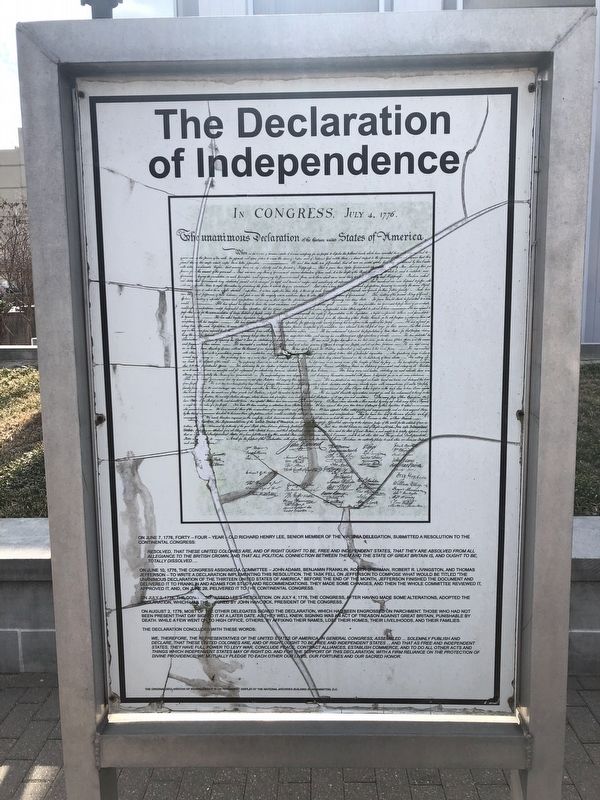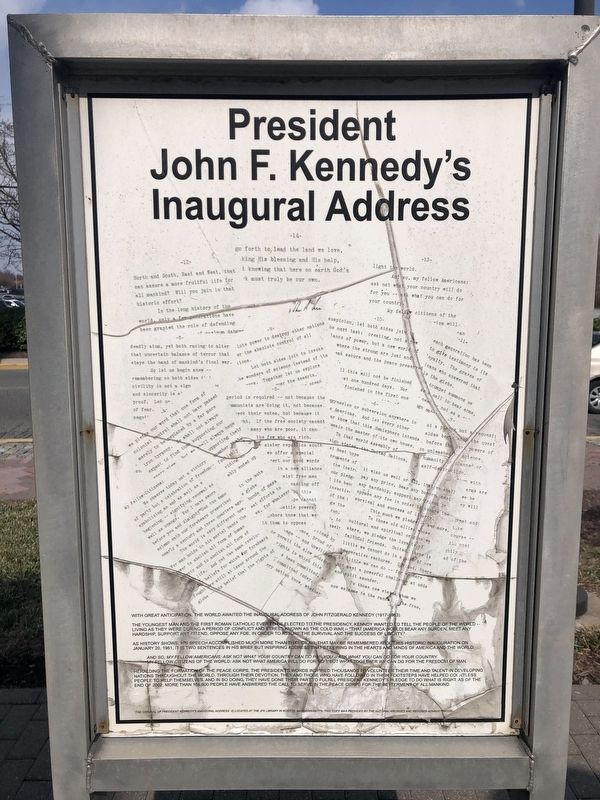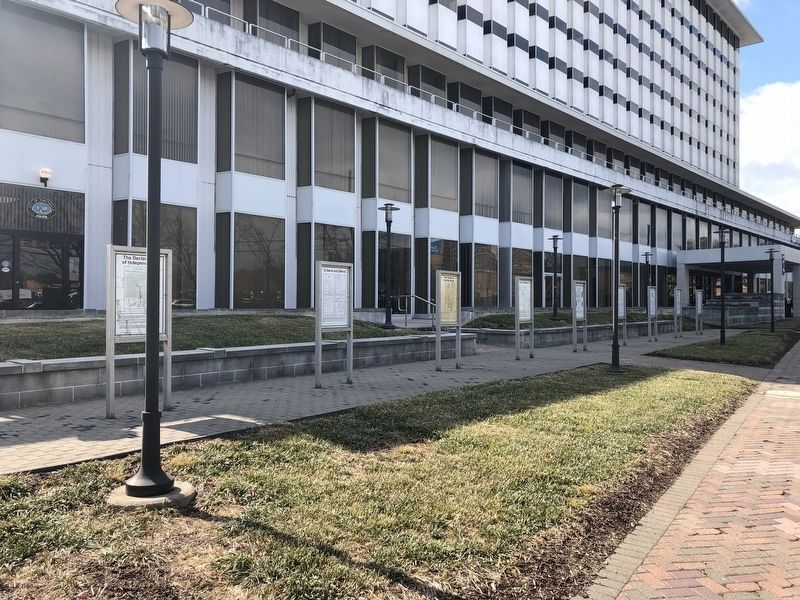Hyattsville in Prince George's County, Maryland — The American Northeast (Mid-Atlantic)
The Declaration of Independence / President John F. Kennedy’s Inaugural Address

Photographed By Devry Becker Jones (CC0), February 28, 2020
1. The Declaration of Independence side of the marker
On June 7, 1776, forty-four-year-old Richard Henry Lee, Senior Member of the Virginia Delegation, submitted a resolution to the Continental Congress:
Resolved, that these United Colonies are, and of right ought to be, free and independent states, that they are absolved from allegiance to the British Crown, and that all political connection between them and the State of Great Britain is, and ought to be, totally dissolved....
On June 10, 1776, the Congress assigned a committee ... John Adams, Benjamin Franklin, Roger Sherman, Robert R. Livingston, and Thomas Jefferson — to write a Declaration implementing this resolution, the task fell on Jefferson to compose what would be titled "The Unanimous Declaration of the Thirteen United States of America." Before the end of the month, Jefferson finished the document and delivered it to Franklin and Adams for study and recommendations. They made some changes, and then the whole committee reviewed it, approved it, and on June 28, Delivered it to the Continental Congress.
On July 3, 1776, this Congress also passed Lee's Resolution, on July 4, 1776, the Congress, after having made some alterations, adopted the Declaration, which was then signed by John Hancock, President of the Congress.
On August 2, 1776, most of the other delegates signed the Declaration, which had been engrossed on parchment. Those who had not been present that they signed it at a later date, as they well knew, signing was an act of treason against Great Britain, punishable by death. While a few went on to high office, others, by affixing their names, lost their homes, their livelihoods, and their families.
The Declaration concluded with these words:
We, therefore, the representatives of the United States of America, in general congress assembled ... solemnly publish and declare, that these United Colonies are, and of right ought to be free, and independent states... and that as free and independent states, they have full power to levy war, conclude peace, contract alliances, establish commerce, and to do all other acts and things which independent states may of right do, and for the support of this Declaration, with a firm reliance on the protection of divine providence we mutually pledge to each other our lives, our fortunes and our sacred honor.
The original Declaration of Independence is on permanent display at the National Archives Building in Washington, D.C.
With great anticipation,

Photographed By Devry Becker Jones (CC0), February 28, 2020
2. President John F. Kennedy's Inaugural Address side of the marker
The youngest man and the first Roman Catholic ever to be elected to the presidency, Kennedy wanted to tell the people of the world — living as they were during a period of conflict and stress known as the Cold War — "that [America would] bear any burden, meet any hardship, support any friend, oppose any foe, in order to assure the survival and the success of liberty.
As history shows, his speech accomplished much more than that of all that may be remembered about his historic inauguration on January 20, 1961, it is two sentences in his brief but inspiring address that still ring in the hearts and minds of America and the world:
And so, my fellow Americans: ask not what your country can do for you — ask what you can do for your country. My fellow citizens of the world: ask not what America will do for you, but what together we can do for the freedom of man.
Heralding the formation of the Peace Corps, the president's words inspired thousands to volunteer their time and talent in developing nations throughout the world through their devotion, they and those who have followed in their footsteps have helped countless people to help themselves, and in so doing, they have done their part to fulfill President Kennedy's

Photographed By Devry Becker Jones (CC0), February 28, 2020
3. The Declaration of Independence / President John F. Kennedy's Inaugural Address Marker
The marker is the leftmost sign visible.
The original of President Kennedy's inaugural address is located at the JFK Library in Boston, Massachusetts. This copy was provided by the National Archives and Records Administration.
Topics and series. This historical marker is listed in these topic lists: Charity & Public Work • Peace • War, Cold • War, US Revolutionary. In addition, it is included in the Former U.S. Presidents: #02 John Adams, the Former U.S. Presidents: #03 Thomas Jefferson, the Former U.S. Presidents: #35 John F. Kennedy, and the Signers of the Declaration of Independence series lists. A significant historical date for this entry is July 4, 1776.
Location. 38° 58.187′ N, 76° 57.139′ W. Marker is in Hyattsville, Maryland, in Prince George's County. Marker is on Toledo Road just west of America Boulevard, on the left when traveling west. Touch for map. Marker is at or near this postal address: 6525 Belcrest Road, Hyattsville MD 20782, United States of America. Touch for directions.
Other nearby markers. At least 8 other markers are within walking distance of this marker. To Serve and Defend / Brown V. Board of Education of Topeka (here, next to this marker); The Treaty at Fort McIntosh / President Franklin Delano Roosevelt's "Day of Infamy" Address (here, next to this marker); The Constitution / The 19th Amendment (a few steps from this marker); A Nation of Immigrants / The Original 13 States (a few steps from this marker); The Bill of Rights / The Statue of Liberty (a few steps from this marker); The Louisiana Purchase / Edison's Light Bulb Patent (a few steps from this marker); The Lewis & Clark Expedition / The 15th Amendment (a few steps from this marker); The Gettysburg Address / The Emancipation Proclamation (within shouting distance of this marker). Touch for a list and map of all markers in Hyattsville.
Also see . . . Top Thirteen Facts about Independence Day. Thirteen minute YouTube video. (Submitted on July 4, 2020.)
Credits. This page was last revised on July 10, 2020. It was originally submitted on February 28, 2020, by Devry Becker Jones of Washington, District of Columbia. This page has been viewed 374 times since then and 9 times this year. Photos: 1, 2, 3. submitted on February 28, 2020, by Devry Becker Jones of Washington, District of Columbia.